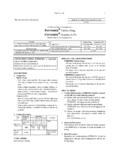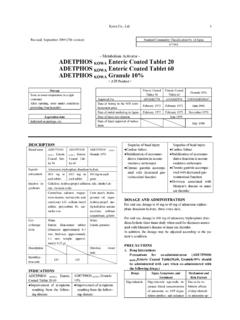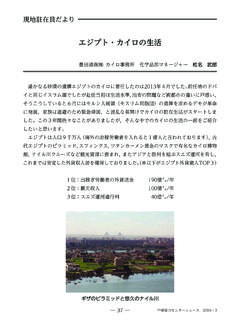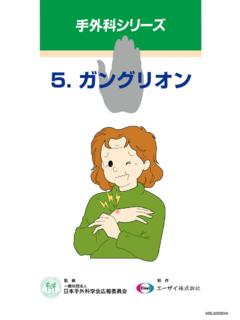Transcription of ALLELOCK Tablets 2.5/5 - e-search.ne.jp
1 Kyowa Hakko Kirin Co., Ltd. 1. Revised: April 2017 (19th version) Standard Commodity Classification No. of Japan 87449. - ANTIALLERGIC AGENT - ALLELOCK Tablets ALLELOCK Tablets 5. <Olopatadine hydrochloride Tablets , JP>. Storage Store at room temperature. Tablets mg Tablets 5 mg Approval No. 21200 AMZ00645 21200 AMZ00646. Date of listing in the NHI reimbursement price February 2001 February 2001. Date of initial marketing in Japan March 2001 March 2001. Expiration date Date of latest reexamination September 2015 September 2015. Do not use after the expiration date Date of latest approval of dosage and administration Children: July 2010. indicated on the package. International birth date December 1996. CONTRAINDICATIONS ( ALLELOCK is Lateral contraindicated in the following patients.) Description Light yellow-red film- Light yellow-red film-coated Patients with a history of hypersensitivity to any of the coated Tablets Tablets components of the product Identification KH020 (Printed on the KH021 (Printed on the code Tablets and PTP) Tablets and PTP).
2 DESCRIPTION. 1. Composition INDICATIONS. Brand name ALLELOCK Tablets ALLELOCK Tablets 5. Adults: Allergic rhinitis, urticaria, itching resulting from skin Active mg of olopatadine 5 mg of olopatadine diseases (eczema/dermatitis, prurigo, pruritus ingredient hydrochloride (JP) in each hydrochloride (JP) in each cutaneous, psoriasis vulgaris, multiform exudative tablet tablet erythema). Inactive Ethyl cellulose, Yellow ferric oxide, Children: Allergic rhinitis, urticaria, itching resulting from ingredient Yellow ferric oxide, Carnauba wax (JP), skin diseases (eczema/dermatitis, pruritus Carnauba wax (JP), Croscarmellose sodium cutaneous). Glycerin fatty acid ester, (JP), Croscarmellose sodium Crystalline cellulose (JP), DOSAGE AND ADMINISTRATION. (JP), Light anhydrous silicic Titanium oxide (JP), Adults: Usually, for adults, administer 5 mg as olopatadine acid (JP), Iron oxide red, hydrochloride twice a day orally in the morning and at Crystalline cellulose (JP), Magnesium stearate (JP), bedtime.
3 Titanium oxide (JP), Lactose hydrate (JP), The dose may be increased or decreased according to Iron oxide red, Hypromellose (JP) (degree Magnesium stearate (JP), of substitution 2910), age and symptoms. Lactose hydrate (JP), Partially Hydrolyzed Children: Usually, for children over 7 years of age, administer Hypromellose (JP) (degree Polyvinyl Alcohol, 5 mg as olopatadine hydrochloride twice a day of substitution 2910), Macrogol 6000 (JP) orally in the morning and at bedtime. Partially Hydrolyzed Polyvinyl Alcohol PRECAUTIONS. 1. Careful Administration ( ALLELOCK should be 2. Product description administered with care in the following patients.). Brand name ALLELOCK Tablets ALLELOCK Tablets 5. (1) Patients with impaired renal function [There is a Diameter mm mm possibility of persistently elevated blood concentrations.]
4 Thickness mm mm Weight g g See PHARMACOKINETICS .]. Face (2) Elderly patients [See Use in the Elderly and PHARMACOKINETICS .]. Reverse (3) Patients with hepatic dysfunction [Hepatic dysfunction may be aggravated.]. Kyowa Hakko Kirin Co., Ltd. 2. 2. Important Precautions 5% <5%, < Incidence (1) Since ALLELOCK may induce drowsiness, patients unknown should be cautioned against engaging in potentially Hypersens Rash including Edema hazardous activities requiring alertness such as itivity* erythema, etc. (face/. operating machinery or driving a car. extremities, etc.), (2) In case ALLELOCK is administered in the patients who itching, have been under chronic treatment with a steroid, dose dyspnea reduction of the steroid should be made gradually under Psychoneu Sleepine Malaise, Mental Involuntary careful supervision.
5 Rologic ss thirst, concentration movement (3) In case ALLELOCK is administered in the patients with headache/ decreased, (face/. seasonal diseases, it is recommended to initiate dull headache, numbness extremities, administration immediately before the typical season to dizziness etc.). be continued until the end of the season. Gastrointe Abdominal Constipation, Vomiting (4) If ALLELOCK dose not exhibit effect, administration stinal discomfort, abdominal stomatitis/angul should not be continued aimlessly for a prolonged time. pain, diarrhea, nausea ar stomatitis/. tongue pain, 3. Adverse Reactions heartburn, increased <Adults>. appetite The collective data from clinical trials before approval, drug Hepatic Hepatic function use-results survey and special survey for long term use abnormal [ALT(GPT), include a total of 1,402 adverse reactions reported from AST(GOT) , LDH, - 1,056 patients ( ) among 9,620 patients treated.]
6 GTP, Al-P and T-Bil The major adverse reactions were sleepiness 674 events increased]. ( ), ALT (GPT) increased 68 events ( ), malaise hematolog Leukocytosis, Leucopenia, 53 events ( ), AST (GOT) increased 46 events ( ), ic eosinophilia, thrombocytope thirst 36 events ( ), etc. (at the end of reexamination). lymphopenia nia <Children> Renal and Occult blood in urine BUN increased, The collective data from clinical trials of ALLELOCK urinary urinary protein positive, (conventional Tablets and granules) in Japan and the special blood creatinine drug-use results surveys of ALLELOCK (conventional increased, Tablets , orally disintegrating Tablets and granules) include a pollakiuria, total of 231 adverse reactions reported from 210 patients dysuria ( ) among 4,413 patients treated. Cardiovas Palpitation, The major adverse reactions were sleepiness 149 events cular blood pressure ( ), ALT (GPT) increased 20 events ( ), AST (GOT) increased increased 9 events ( ), leukocytosis 7 events ( ), Others Serum cholesterol Urine sugar Menstrual dis- nausea 4 events ( ), etc.
7 (at the end of reexamination). increased positive, order, chest myalgia, (1) Clinically significant adverse reactions discomfort, arthralgia Fulminant hepatitis, hepatic function disorder, taste jaundice (incidence unknown): Fulminant hepatitis, abnormality, hepatic function disorder with increases of AST(GOT), weight ALT(GPT), -GTP, LDH and Al-P, etc. and jaundice increase, hot may occur. Patients should be carefully observed, and, flushes in the event of abnormalities, treatment should be *In case of the occurrence of these symptoms, administration discontinued and appropriate measures should be taken. should be discontinued. (2) Other adverse reactions Since the following adverse reactions may occur, 4. Use in the Elderly patients should be observed carefully. In the event of Since elderly patients often have reduced physiological abnormalities, appropriate measures such as dose function and are more likely to develop adverse reactions, reduction or temporary discontinuation of ALLELOCK should be administered cautiously by starting administration should be taken.
8 At a low dose while monitoring the patient's condition. 5. Use during Pregnancy, Delivery or Lactation (1) ALLELOCK should be used in pregnant women or in women who may possibly be pregnant only if the expected therapeutic benefits outweigh the possible Kyowa Hakko Kirin Co., Ltd. 3. risks associated with treatment. [Safety of the administration during pregnancy has not been Pharmacokinetic parameters established.] Parameter Cmax Tmax T1/2 AUC0- . (2) Lactating women should not be given ALLELOCK . If Dose (ng/mL) (h) (h) ( ). treatment with this drug is judged to be essential, breast 5 mg * 326 63*. feeding must be discontinued during treatment. 10 mg ** 638 136**. [Animal studies (rats) reported excretion of this drug in mean *: n=4, **: n=10. breast milk and weight increase inhibition of the neonates.]. 2)Repeated dose1).
9 6. Pediatric Use When 10 mg of olopatadine hydrochloride was orally The safety of ALLELOCK in low-birth-weight babies, administerd to 8 healthy male adults by repeated newborns, sucklings or infants has not been established administration of 13 doses, twice daily for 6 days and (insufficient clinical experience). once on day 7, the plasma concentration reached the steady state before day 4 of administration. The Cmax was times that after a single oral dose. (measured 7. Effects on Laboratory Tests by RIA). Since the administration of ALLELOCK inhibits the intradermal reaction to allergens and thus interferes with the (2) Patients with impaired renal function (not on identification of potential allergens, ALLELOCK should not dialysis) 2). When a single dose of 10 mg of olopatadine be administered prior to intradermal allergen tests.
10 Hydrochloride was orally administered after breakfast to patients with impaired renal function ( to 8. Precautions concerning Use mL/min creatinine clearance), the mean plasma (1) Precautions regarding dispensing concentration-time profile is as follows. The Cmax and For drugs dispensed in press-through package (PTP), AUC in patients with impaired renal function were instruct the patient to remove the drug from the package and 8 times of those in healhty adults, respectively. prior to use. [It has been reported that, if the PTP sheet (measured by RIA). is swallowed, the sharp corner of the sheet may puncture the esophageal mucosa, resulting in severe complications such as mediastinitis.]. (2) Cautions in the use of scored Tablets Tablets after divided should be stored in a light-proof containuer. 9. Other Precautions It was reported that myocardial infarction occurred during treatment with this drug, though the causal relationship is unknown.
















